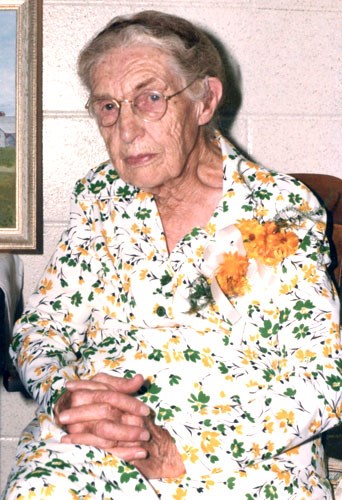As a grassroots committee of Weyburn area residents reaches the halfway point in their goal to raise funds for a Pioneer Woman statue for Weyburn, a long-time area resident Audrey Nerbas shared the story of her grandmother, Leah Brock, as an example of what pioneer women did in helping to establish the community.
The project seeks to honour the pioneer women who helped settle the area, and a statue has been commissioned from Alberta sculptors Shirley and Don Begg of Cochrane, who own their own foundry and studio.
In addition, the committee is also proposing to put together a book with stories of pioneer women from the region; one of the contributors so far, Audrey Nerbas, put together a story about Leah Brock, who was honoured in 1973 by Beta Sigma Phi as the first ever Lady of the Year at the age of 85. In 1980, she was honoured as Oungre's Saskatchewan Pioneer Queen, at age 92, a year before she passed away.
Nerbas believes this statue and book project is important, partly so local residents don't lose a piece of their history as these people who helped establish this community pass on and their memories are forgotten.
"You hear about the men and what they did, but the women, like my grandmother, did a lot more than just running a household. They were behind the scenes supporting the men, so I think a project like this is important. These women made valuable contributions above and beyond and did so with very limited resources," said Nerbas.
"The men were running in elections or breaking ground, but they couldn't have done it without the women. A lot of them didn't come from here; my grandmother came from a well-established community and came to nothing. I can't imagine raising nine kids without running water or electricity, but it was never 'woe is me', ever," she added.
Leah Porter was a 21-year-old teacher who lived in Forest, Ont., and came by train to marry Joe Brock in 1909, arriving in Moose Jaw and travelling by horse and democrat to the home Brock had built near McTaggart, five miles west of Weyburn. This would be their home for the next 49 years until they left the farm, passing it on to sons Bud and Russell when they moved in to Weyburn in 1958.
In her memories, Leah recalled seeing the steam from 15 steam threshers one morning; she arrived at threshing time, with a threshing crew on their farm, complete with a cook car. This was the only harvest time where she wasn't called upon to cook meals for her family and for the threshing crews; she and Joe went on to raise 10 children over 17 years, with one dying in infancy.
As her husband worked off-farm as a land locator besides running their farm, for some years they alternated between running the farm at McTaggart and establishing one at Ogema and in the Brokenshell area.
This meant packing up the family and moving between locations for as much as six months at a time. Joe's job also meant Leah was left in charge of daily chores, livestock and generally keeping everything together.
She experienced her first prairie blizzard that winter, on December 31, 1909; it blew out during the night, but by morning the storm had killed 29 people throughout the province.
Another major challenge she encountered was when Joe contracted typhoid fever, and was hospitalized for 100 days; there were also incidents of fires burning down their barns, or raging across the prairies, destroying horses, harnesses and feed a couple of times.
There were simple pleasures of prairie life as well, with picnics, concerts and ball games at West Weyburn School, which also hosted occasional church services and housed a regular Sunday School for many years.
Berry picking was also one of her pleasures, as was quilt-making. Besides raising her nine children, Leah was also very involved in many community groups and organizations, including early on being involved in Saskatchewan's Co-operative movement, the United Church, and in 1944 she was one of the eight charter members of the Weyburn Credit Union.
She was secretary of the women's section of United Grain Growers for 31 years, and helped lobby the federal government to protest an increase in freight rates. She was also secretary for the Farmers Union local, Aid for Aging, and the Pensioners and Senior Citizens group.
"This was a woman who never sat idle. It was not uncommon to see her with knitting in hand, doing a crossword puzzle, and carrying on a lively discussion, all at the same time," said Nerbas.
She added, an example of her philosophy could be summed up in this statement: "If something is difficult to get, you make better use of it."
Nerbas said this reflected the hard sort of life she had as a pioneer, and the sense of thrift she developed as part of her lifestyle.
"She did what she had to do. If she heard what we were saying about her now, she would've said she was just one of many who did the same thing," said Nerbas. "She and the women like her set the foundation of the community."
It was with this thought in mind about the pioneer women that the statue committee has set this project in motion.
The committee includes Ross McMurtry, Isabelle Butters, Mayvis Goranson, Stan Runne, Heather van der Breggen, Leo Leydon and Jan Linnell. Stories about pioneer women can be sent to Jan Linnell, Mayvis Goranson or Isabelle Butters, or can be sent to the Facebook page, Pioneer Women Sculpture.
The committee is aiming to have the stories collected and printed in a book form, to help future generations remember who the pioneer women of this region were.
